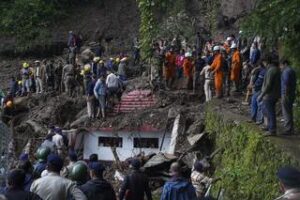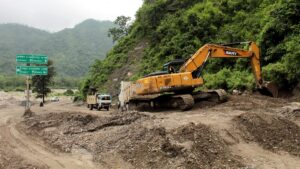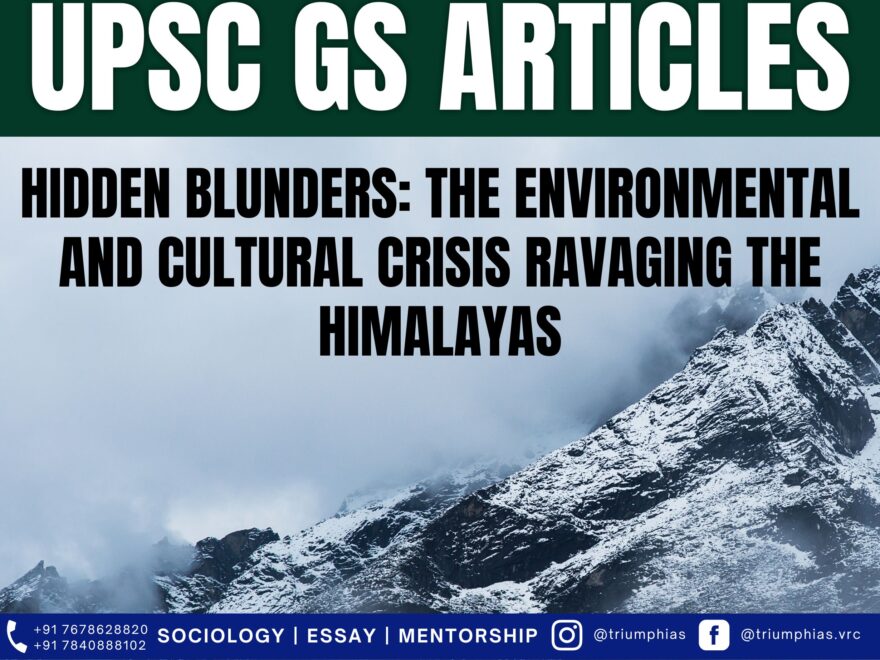Himalayas: Hidden blunders that are ravaging himalyas
(Relevant for General Studies Paper Prelims/Mains)

Himalayas
Nestled in the heart of Asia, the Himalayan mountain range, often hailed as the “Topmost Crown of the World,” has held humanity’s fascination for centuries due to its awe-inspiring beauty and allure.
However, concealed beneath its tranquil exterior lies a narrative of escalating environmental trials. In recent times, the Himalayas have observed an array of unparalleled and disconcerting challenges that cast a shadow on their very existence.
Ranging from the consequences of climate change that result in glacial retreat and altered climatic patterns, to uncontrolled urban expansion and unsustainable developmental approaches, the Himalayas confront a surge of devastation that calls for immediate action.
Grasping the intricate equilibrium that upholds the Himalayas has emerged not only as a regional concern but as a worldwide necessity. The predicament faced by the Himalayas demands urgent attention and united endeavours on a global level.
Significance of himalayas
- Cultural and Spiritual Significance: The Himalayas hold deep spiritual and cultural importance for various faiths and traditions, including Hinduism, Buddhism, and Jainism. This majestic range is adorned with revered pilgrimage destinations, monastic retreats, and temples, often associated with practices like meditation, enlightenment, and self-discovery.
- Biodiversity Hub: The Himalayan realm is acknowledged as a global hotspot for biodiversity, playing a pivotal role in maintaining ecological equilibrium. Its diverse landscapes, ranging from dense forests to high-altitude meadows, nurture a remarkable array of plant and animal species, some of which are found nowhere else on Earth.
- Water Reservoir: The Himalayan glaciers and snowfields serve as the primary sources for major rivers such as the Ganges, Indus, Brahmaputra, and Yangtze, upon which the livelihoods of millions in South Asia depend. The rivers provide water for agricultural activities, hydropower generation, and sustenance for urban communities downstream.
- Climate Control: The Himalayas exert a significant influence on regional and even global climate patterns. They steer monsoon systems that deliver essential rainfall to nations like India, Nepal, and Bangladesh. Furthermore, the Himalayan glaciers act as sensitive indicators of broader climatic changes.
- Geological Significance: The Himalayas are the result of an ongoing collision between the Indian Plate and the Eurasian Plate. This geological process has shaped the landscape and continues to impact seismic events in the area. In-depth exploration of the Himalayas offers valuable insights into the Earth’s tectonic dynamics and enriches scientists’ comprehension of mountain formation processing.
- Flawed Development: Instances like the road blockage caused by a landslide in Chamoli, the sinking of Joshimath in Uttarakhand, and the road collapse in Chamba, Himachal Pradesh, exemplify a flawed approach to development that has been ingrained in the Himalayan region. Research conducted by the National Remote Sensing Center (under ISRO) has unveiled that Rudraprayag and Tehri districts are the most landslide-prone areas in the country. The ambitious Chardham Mahamarg Vikas Pariyojna, a massive infrastructure initiative, has resulted in the loss of numerous trees, vast stretches of forest land, and the fertile topsoil of the delicate Himalayan terrain.
- Unregulated Tourism: While tourism can bring economic advantages, uncontrolled tourism can exert strain on local resources and ecosystems. Mountainous regions are grappling with the burden of excessive tourism and the migration of rural populations to urban areas. In the year 2022 alone, around 100 million tourists, including pilgrims, flocked to Uttarakhand. Experts consistently caution that unchecked tourism beyond the region’s carrying capacity could have dire consequences.
- Elevated Temperatures: The Himalayas are experiencing a more rapid warming trend compared to other mountain ranges. The increased use of reinforced concrete in construction, replacing the traditional wood and stone masonry, could potentially generate a heat island effect and contribute to regional warming.
- Cultural Erosion: The traditional communities of the Himalayas possess unique cultural traditions and lifestyles deeply interwoven with their natural environment. Unsustainable urban growth is eroding traditional knowledge, customs, and cultural heritage.
- Climate Change and Glacial Retreat: The Himalayas are particularly susceptible to the impacts of climate change. Escalating temperatures have accelerated glacier melt, impacting water availability downstream. This poses substantial risks to communities reliant on glacial melt water for agriculture, drinking water, and hydropower.
- Accumulation of Black Carbon: A major catalyst for glacier melting is the emission of black carbon aerosols into the atmosphere. Black carbon absorbs light and emits infrared radiation, raising temperatures. The increased presence of black carbon in the Himalayas accelerates glacier melt. Black carbon deposits on the Gangotri glacier have surged, intensifying its melting. Gangotri holds the distinction of being the fastest receding glacier.
- Natural Disasters: The Himalayas, as youthful fold mountains, are still uplifting and prone to tectonic activities. This renders the region susceptible to natural disasters such as landslides, avalanches, and earthquakes. Climate change could exacerbate the frequency and severity of these events, leading to loss of life, property damage, and disruptions to infrastructure. Soil
- Erosion and Landslides: Activities like deforestation, construction, and improper land use practices escalate soil erosion and landslide risks. The depletion of vegetative cover destabilizes Himalayan slopes, rendering them vulnerable to erosion during intense rainfall or seismic occurrences.
- Proliferation of Invasive Species: As temperatures rise, new habitats open up for invasive species that can outcompete the indigenous flora and fauna of the Himalayan region. Invasive species upset the delicate ecosystem balance and jeopardize the survival of native species.
Initiatives taken so far
National Mission on Sustaining Himalayan Ecosystem:
- It was launched in 2010 and covers 11 states (Himachal Pradesh, Uttarakhand, Sikkim, all northeast states and West Bengal) and 2 UTs (J&K and Ladakh).
- It is one of the eight missions under the National Action Plan on Climate Change (NAPCC).
- SECURE Himalaya Project:
- It is a part of “Global Partnership on Wildlife Conservation and Crime Prevention for Sustainable Development” (Global Wildlife Program) funded by the Global Environment Facility (GEF).
- It promotes sustainable management of alpine pastures and forests in the high range Himalayan ecosystems.
- Mishra Committee Report 1976:
- Named after MC Mishra (then Garhwal commissioner in erstwhile UP), the committee gave itsfindings about land subsidence in Joshimath.

What steps can be taken
- NDMA Guidelines for GLOFs: To address the issue of unregulated tourism, the National Disaster Management Authority (NDMA) has put forth a set of recommendations aimed at establishing a buffer zone and regulating tourism activities in areas prone to Glacial ake Outburst Floods (GLOFs). These measures intend to curtail pollution and mitigate risks in these regions.
- Cross-Border Collaboration: Himalayan nations should establish an international network for monitoring risks associated with phenomena like glacial lakes and providing early warnings for potential hazards. This approach parallels the development of tsunami warning systems across the Indian Ocean in the past decade. It is imperative for countries to exchange and disseminate knowledge concerning mountainous terrain and the preservation of its ecology.
- Education and Awareness: Enhancing the understanding of the Himalayan people about the geological vulnerabilities and ecological sensitivities of their mountain habitat could encourage greater adherence to laws and regulations aimed at safeguarding it. Integrating fundamental knowledge about the geology and ecology of the Himalayas into school curricula is essential for India and other affected countries. By educating students about their surroundings, a stronger sense of connection to the land and heightened awareness of its well-being can be fostered.
- Role of Local Governance: Municipalities in Himalayan states should adopt a more proactive stance when granting building approvals. Building codes must be revised to effectively tackle emerging climate change challenges. Disaster management departments should shift their focus towards flood prevention and preparedness strategies.
- Additional Crucial Measures: Implementing advanced early warning systems and more accurate weather forecasts to predict disasters and alert both local residents and tourists promptly. Assessing the current state of the region and devising a sustainable plan that takes into account the unique requirements of the fragile environment and the impacts of climate change. Initiating a discourse on the adverse consequences of commercial tourism while advocating for the promotion of ecotourism. Mandatory issuance of Detailed Project Reports (DPRs), Environmental Impact Assessments (EIAs), and Social Impact Assessments (SIAs) before embarking on any project. Enhancing the structural stability of existing dams and prioritizing regular monitoring following instances of flooding.
Sample Question for UPSC Sociology Optional Paper:
- Question: Discuss the impact of climate change on the social fabric of communities residing in the Himalayas.
Short Answer: Climate change, through glacial retreat and altered weather patterns, not only affects the natural resources but also disrupts the traditional ways of life. The social fabric is strained as communities struggle for resources like water and land, leading to increased migration, loss of traditional knowledge, and alteration of community structures. - Question: Examine the role of tourism in shaping and reshaping socio-cultural values in the Himalayan region.
Short Answer: Tourism brings economic prosperity but at the cost of diluting traditional socio-cultural values. Over-commercialization of sacred spaces and an influx of external cultural norms pose challenges to maintaining the unique cultural identity of the Himalayan communities. - Question: How does unsustainable development exacerbate social inequalities in the Himalayan region?
Short Answer: Unsustainable development, often driven by the needs of the urban population or external interests, tends to exploit local resources and labor. This can widen social inequalities, as local communities may not equally benefit from these developments and may suffer from environmental degradation. - Question: What are the implications of biodiversity loss on the livelihood of Himalayan communities?
Short Answer: The loss of biodiversity negatively impacts the livelihoods dependent on farming, fishing, and foraging, thereby affecting income, food security, and ultimately leading to socio-economic imbalances within the community. - Question: Assess the effectiveness of local governance in disaster management in the Himalayan states.
Short Answer: The effectiveness of local governance varies but is generally lacking in resources and expertise. There is a need for stronger policy frameworks, capacity-building, and community engagement for a more effective disaster management strategy.
To master these intricacies and fare well in the Sociology Optional Syllabus, aspiring sociologists might benefit from guidance by the Best Sociology Optional Teacher and participation in the Best Sociology Optional Coaching. These avenues provide comprehensive assistance, ensuring a solid understanding of sociology’s diverse methodologies and techniques.
Himalayas, Climate Change, Glacial Retreat, Biodiversity, Water Reservoir, Tourism, Environmental Impact, Sustainable Development, Cultural Heritage, Disaster Management, Himalayas, Climate Change, Glacial Retreat, Biodiversity, Water Reservoir, Tourism, Environmental Impact, Sustainable Development, Cultural Heritage, Disaster Management, Best Sociology Optional Coaching, Sociology Optional Syllabus.

Why Vikash Ranjan’s Classes for Sociology?
Proper guidance and assistance are required to learn the skill of interlinking current happenings with the conventional topics. VIKASH RANJAN SIR at TRIUMPH IAS guides students according to the Recent Trends of UPSC, making him the Best Sociology Teacher for Sociology Optional UPSC.
At Triumph IAS, the Best Sociology Optional Coaching platform, we not only provide the best study material and applied classes for Sociology for IAS but also conduct regular assignments and class tests to assess candidates’ writing skills and understanding of the subject.
Choose The Best Sociology Optional Teacher for IAS Preparation?
At the beginning of the journey for Civil Services Examination preparation, many students face a pivotal decision – selecting their optional subject. Questions such as “which optional subject is the best?” and “which optional subject is the most scoring?” frequently come to mind. Choosing the right optional subject, like choosing the best sociology optional teacher, is a subjective yet vital step that requires a thoughtful decision based on facts. A misstep in this crucial decision can indeed prove disastrous.
Ever since the exam pattern was revamped in 2013, the UPSC has eliminated the need for a second optional subject. Now, candidates have to choose only one optional subject for the UPSC Mains, which has two papers of 250 marks each. One of the compelling choices for many has been the sociology optional. However, it’s strongly advised to decide on your optional subject for mains well ahead of time to get sufficient time to complete the syllabus. After all, most students score similarly in General Studies Papers; it’s the score in the optional subject & essay that contributes significantly to the final selection.
“A sound strategy does not rely solely on the popular
Opinion of toppers or famous YouTubers cum teachers.”
It requires understanding one’s ability, interest, and the relevance of the subject, not just for the exam but also for life in general. Hence, when selecting the best sociology teacher, one must consider the usefulness of sociology optional coaching in General Studies, Essay, and Personality Test.
The choice of the optional subject should be based on objective criteria, such as the nature, scope, and size of the syllabus, uniformity and stability in the question pattern, relevance of the syllabic content in daily life in society, and the availability of study material and guidance. For example, choosing the best sociology optional coaching can ensure access to top-quality study materials and experienced teachers. Always remember, the approach of the UPSC optional subject differs from your academic studies of subjects. Therefore, before settling for sociology optional, you need to analyze the syllabus, previous years’ pattern, subject requirements (be it ideal, visionary, numerical, conceptual theoretical), and your comfort level with the subject.
This decision marks a critical point in your UPSC – CSE journey, potentially determining your success in a career in IAS/Civil Services. Therefore, it’s crucial to choose wisely, whether it’s the optional subject or the best sociology optional teacher. Always base your decision on accurate facts, and never let your emotional biases guide your choices. After all, the search for the best sociology optional coaching is about finding the perfect fit for your unique academic needs and aspirations.
To master these intricacies and fare well in the Sociology Optional Syllabus, aspiring sociologists might benefit from guidance by the Best Sociology Optional Teacher and participation in the Best Sociology Optional Coaching. These avenues provide comprehensive assistance, ensuring a solid understanding of sociology’s diverse methodologies and techniques. Sociology, Social theory, Best Sociology Optional Teacher, Best Sociology Optional Coaching, Sociology Optional Syllabus.
Best Sociology Optional Teacher, Sociology Syllabus, Sociology Optional, Sociology Optional Coaching, Best Sociology Optional Coaching, Best Sociology Teacher, Sociology Course, Sociology Teacher, Sociology Foundation, Sociology Foundation Course, Sociology Optional UPSC, Sociology for IAS,
Follow us :
🔎 https://www.instagram.com/triumphias
🔎https://www.youtube.com/c/TriumphIAS
https://t.me/VikashRanjanSociology
Find More Blogs
|
Scope of the subject and comparison with other social sciences |
|||
|
|
|
|
Modernity and social changes in Europe |

